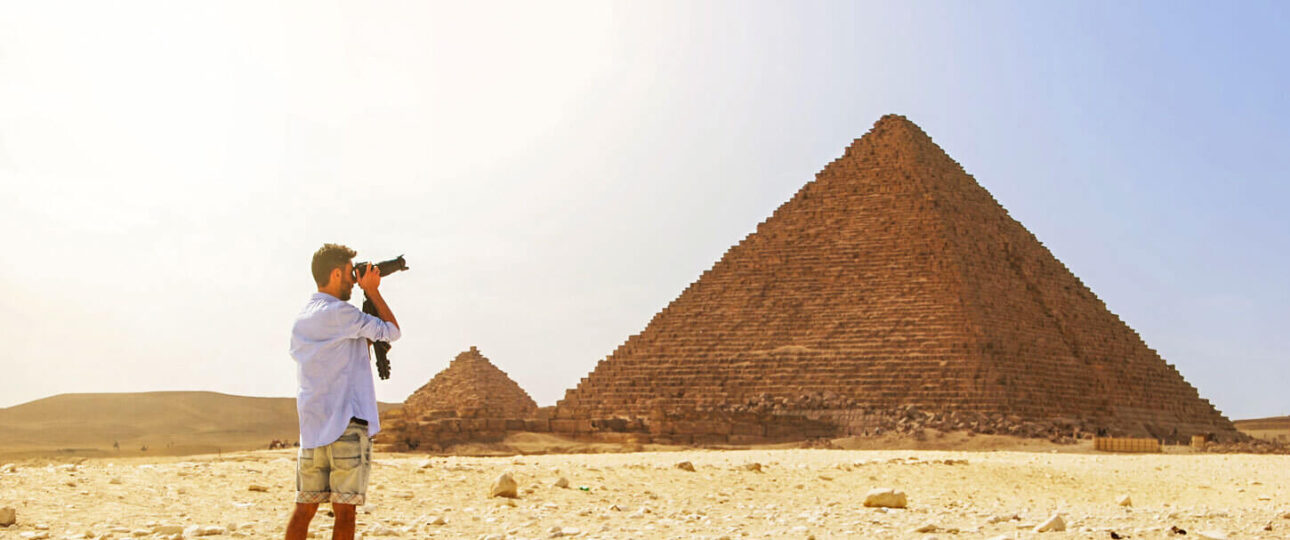Pyramid of Menkaure: Ancient Egyptian Architectural Brilliance
The Pyramid of Menkaure stands as a testament to the grandeur and architectural mastery of the ancient Egyptians. Located on the Giza Plateau in Egypt, it is one of the three main pyramids in the complex, along with the Great Pyramid of Khufu and the Pyramid of Khafre. Constructed during the 4th Dynasty of the Old Kingdom, the Pyramid of Menkaure has captivated historians, archaeologists, and tourists for centuries. Let’s embark on a journey through time and unravel the mysteries of this remarkable structure.
Pyramid of Menkaure, A Glimpse into Ancient Egypt’s Legacy
The Pyramid of Menkaure, also known as Mykerinos, was built as the final resting place of Pharaoh Menkaure, who ruled Egypt during the 26th century BCE. This pyramid showcases the evolving architectural techniques employed by the ancient Egyptians and offers a unique window into their rich cultural heritage.
- Exploring the Rich Flavors of Egypt’s Traditional Food
The Enigmatic Design of the Pyramid
The Pyramid of Menkaure stands approximately 66 meters (215 feet) tall and was constructed using limestone blocks. Its base measures 108 meters (354 feet) on each side, creating a perfect square. The pyramid initially had a smooth outer casing made of Tura limestone, giving it a stunning appearance.
Ancient Egyptian Pyramid Design
The design of the Pyramid of Menkaure incorporates elements commonly found in other ancient Egyptian pyramids. The pyramid follows a traditional four-sided, triangular shape, with each side facing one of the cardinal directions. The complex internal structure includes a series of corridors, chambers, and an impressive burial chamber.
Unraveling the Mysteries of the Pyramid
Despite centuries of exploration and study, the Pyramid of Menkaure still holds many mysteries waiting to be uncovered. Archaeologists and researchers have dedicated themselves to unraveling the secrets concealed within its walls. Let’s delve into some of the most intriguing aspects of this ancient wonder.
The Pyramid’s Intricate Internal Structure
The Pyramid of Menkaure’s internal structure showcases the ancient Egyptians’ advanced engineering and architectural skills. The pyramid consists of several passages and chambers, leading to the burial chamber where Pharaoh Menkaure was laid to rest.
The Mysterious Sphinx Connection
Adjacent to the Pyramid of Menkaure lies the Great Sphinx, a majestic limestone statue with a human’s head and a lion’s body. The relationship between the Sphinx and the Pyramid Complex remains a subject of speculation and intrigue. Some theories suggest that the Sphinx was a guardian of the pyramid, while others propose a deeper symbolic connection between the two structures.
Sphinx Symbolism in Ancient Egypt
The Controversy Surrounding the Pyramid’s Casing Stones
One of the most debated aspects of the Pyramid of Menkaure is the missing outer casing stones. Unlike its neighboring pyramids, the Pyramid of Menkaure lacks the smooth, polished exterior that once adorned it. Scholars have put forth various hypotheses to explain the absence of these stones, ranging from weathering and erosion to repurposing for other construction projects.
The Pyramids as Astronomical Alignments
Ancient Egyptian pyramids, including the Pyramid of Menkaure, exhibit remarkable alignment with celestial bodies. Researchers believe that the orientation and positioning of the pyramids were deliberate, representing the ancient Egyptians’ connection with the cosmos. The Pyramid of Menkaure aligns with certain stars, such as Aldebaran and Orion’s Belt, further highlighting the astronomical significance of these structures.
How long did it take to build the Pyramid of Menkaure?
The construction of the Pyramid of Menkaure spanned several decades. It is estimated that it took around 14 to 20 years to complete, employing thousands of skilled workers and artisans.
Why is the Pyramid of Menkaure smaller than the Great Pyramid of Khufu?
The size difference between the Pyramid of Menkaure and the Great Pyramid of Khufu can be attributed to variations in the pharaohs’ reigns, architectural preferences, and historical circumstances. Each pyramid served as the burial place for a different pharaoh, resulting in variations in scale and design.
What treasures were found inside the Pyramid of Menkaure?
When the Pyramid of Menkaure was first explored in the modern era, several artifacts and funerary items were discovered inside the pyramid. These included statues, jewelry, and other offerings meant to accompany the pharaoh in the afterlife.
Can visitors enter the Pyramid of Menkaure?
No, the Pyramid of Menkaure is not accessible to visitors for safety and preservation reasons. However, tourists can explore the exterior and witness the awe-inspiring structure from the outside.
What is the significance of the Pyramid of Menkaure in Egyptian history?
The Pyramid of Menkaure represents a significant part of ancient Egyptian history and culture. It reflects the power and authority of Pharaoh Menkaure, provides insights into ancient architectural practices, and serves as a testament to the religious and spiritual beliefs of the time.
Are any ongoing excavations or research projects at the Pyramid of Menkaure?
While there have been past excavation and research efforts at the Pyramid of Menkaure, there are currently no ongoing projects at the site. However, the pyramid and its surroundings inspire scholarly interest and curiosity.
- Don’t Forget to Explore Egypt’s Travel Tips
Conclusion
The Pyramid of Menkaure is an enduring symbol of the ancient Egyptians’ architectural brilliance, cultural heritage, and religious beliefs. Its impressive design, intriguing internal structure, and mysterious connections to the Sphinx continue to fascinate both researchers and visitors from around the world. Exploring the Pyramid of Menkaure offers a remarkable glimpse into the ancient world and its enduring legacy.

